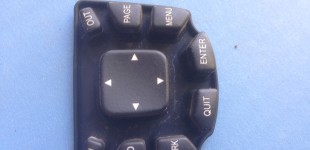Is your car GPS screen marred by unsightly scratches, making navigation a frustrating experience? Over time, the screens of our car GPS devices can become scratched from daily use, accidental bumps, or even just cleaning. Garmin, a popular GPS brand, offers out-of-warranty repairs, but this can be costly and time-consuming. Before you consider expensive professional repairs or replacements, you might be surprised to learn that you can effectively repair these scratches yourself using a simple and affordable headlight restoration kit. This guide will walk you through the process of how to repair scratches on your car GPS screen, saving you money and restoring clarity to your device.
What You’ll Need
Before you begin, gather the following materials:
- Headlight Restoration Kit: These kits are readily available at most auto parts stores or online. They typically include various grades of sandpaper (800, 1500, 2000 grit), polishing compound, and applicator pads.
- Small Phillips Head Screwdriver or Torx Screwdriver: The type of screwdriver will depend on the screws used in your specific GPS device. Check your device beforehand.
- Soft Cloths or Microfiber Towels: For cleaning and polishing.
- Water: For wet sanding.
- Optional: Masking tape (though as we’ll see, it might not be necessary).
- Optional: Drill with a polishing attachment (some kits include this, but hand sanding is also effective).
Step-by-Step Guide to Repairing Scratches
Step 1: Disassemble the GPS Unit
Carefully turn off and detach your GPS unit from its mount and power source. Locate the screws on the back of the device. In this example, a Garmin GPSMAP 64 uses six 1.3mm Torx screws. Using the correct screwdriver, remove all the screws. Keep them organized in a safe place so you don’t lose them during the repair process.
Once the screws are removed, gently pry apart the two halves of the GPS casing. Be cautious as you separate the sections. The screen and antenna assembly are usually attached to the bottom part of the case. You’ll need to lift the bottom section slightly and then slide it to the side to disengage the antenna from its housing. Set the electronic components aside in a dry, safe place, away from dust and moisture. You should now be left with the front plastic shell containing the scratched GPS screen.
To remove the screen for easier access, gently push on the rubber keyboard membrane from the back of the plastic shell. This should pop the screen assembly out of the front casing.
At this point, you can clearly see the scratches on the GPS screen that need repair.
Step 2: Sanding the Scratches
Take the 800-grit sandpaper from your headlight restoration kit. Dampen the screen with a little water. Begin sanding the screen in a circular motion, applying even and gentle pressure. Keep the screen surface wet throughout the sanding process to help remove debris and provide lubrication. You might feel uneasy sanding your GPS screen, but this is a necessary step to remove the scratches. As you sand, a milky residue will form – this is normal.
After sanding with the 800-grit paper for a few minutes, switch to the 1500-grit sandpaper. Repeat the wet sanding process, again using gentle, even pressure and circular motions. The 1500-grit paper refines the surface after the coarser 800-grit paper.
Step 3: Further Sanding and Inspection
Next, move to the 2000-grit sandpaper. Continue wet sanding the screen, maintaining even pressure and circular motions. The 2000-grit sandpaper is very fine and will further smooth the screen, reducing haze and preparing it for polishing.
Periodically rinse the screen with water and inspect your progress. If you still see deep scratches, you may need to repeat the sanding steps, starting again with the 800-grit sandpaper and progressing through the grits.
Step 4: Polishing the Screen
Once you are satisfied that the scratches are minimized, dry the screen thoroughly with a soft, clean cloth. Apply a small amount of the polishing compound from your headlight restoration kit to a clean applicator pad or microfiber cloth. Firmly polish the screen in circular motions. This step is crucial for restoring the clarity and shine to your GPS screen. Spend a good amount of time polishing to achieve the best results.
Step 5: Final Cleaning and Reassembly
After polishing, clean the screen again with a clean, damp cloth to remove any remaining polishing compound residue. Ensure the screen is completely dry and free of any streaks or haze. Clean both sides of the screen for optimal clarity.
Carefully reassemble your GPS unit by reversing the disassembly steps. Place the screen back into the front casing, ensuring it’s properly seated. Align the front and back casings, making sure the rubber gasket (if present) is correctly positioned to maintain a seal. Finally, reinsert and tighten all the screws.
Step 6: Test Your Repaired GPS Screen
Power on your GPS device and check the screen. The scratches should be significantly reduced or even completely gone, and the screen should be clear and easy to read.
Troubleshooting
- Scratches Still Visible: If scratches persist, repeat the sanding process, starting again with the 800-grit sandpaper and progressing through the finer grits, spending more time on each step.
- Hazy Screen: If the screen appears hazy after sanding, spend more time polishing with the 2000-grit sandpaper and polishing compound. You may need to go back to the 1500-grit sandpaper briefly and then return to the 2000-grit and polishing.
- Uneven Surface/Round Spot: This can occur from applying uneven pressure during sanding, especially if using a drill attachment. If it’s minor, you might choose to live with it. For more noticeable unevenness, try using a block sander with the 800-grit sandpaper to level the surface, then repeat the sanding and polishing steps.
- Case Won’t Close Properly: Double-check the rubber gasket around the case perimeter. If it’s dislodged, carefully reseat it in its groove before reassembling the case.
By following these steps, you can effectively repair scratches on your car GPS screen, restoring its clarity and extending the life of your device. This DIY method is a cost-effective alternative to professional repairs and allows you to regain clear visibility for safer and more enjoyable navigation.


